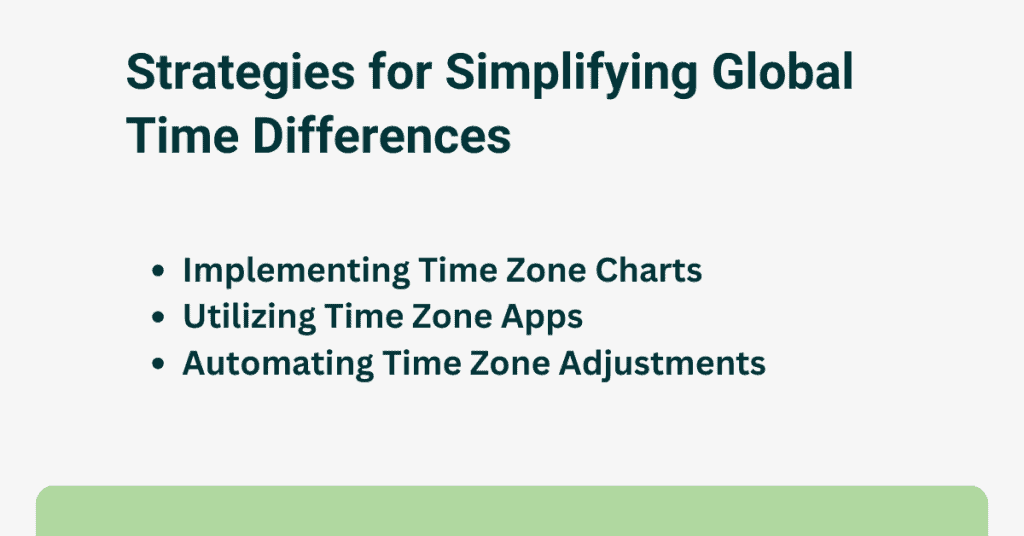In the realm of global outsourcing, understanding and effectively managing time zone differences is paramount. Time zone discrepancies can either be a boon or a bane to businesses engaging in outsourcing to India. It’s not merely about synchronising clocks; it’s about synchronising workflows, communication, and ultimately, productivity. Let’s delve into the importance, challenges, and strategies for navigating these complexities.
To overcome time zone differences when outsourcing to India, schedule regular meetings at convenient times for both parties, utilize communication tools like Slack or Zoom, and establish clear communication protocols to ensure effective collaboration despite the time gap.
Time zone differences significantly impact the seamless flow of operations between outsourcing partners. For instance, while it might be midday in one country, it could be late evening in another. Such misalignments can lead to delays in communication, project bottlenecks, and even missed deadlines. Hence, managing time zone differences becomes pivotal for maintaining operational efficiency and meeting client expectations.
Navigating time zone differences presents multifaceted challenges. Firstly, coordinating meetings and virtual collaborations becomes intricate due to conflicting working hours. Secondly, there’s a heightened risk of miscommunication or delayed responses, leading to misunderstandings and project setbacks. Moreover, the implementation of daylight saving time adjustments further complicates the equation, requiring constant vigilance and adjustment.
To overcome these challenges, businesses must deploy robust strategies tailored to mitigate the impact of time zone differences. Leveraging technological aids such as world clocks and time zone differences, calculators streamline scheduling and fosters real-time collaboration. Adhering to international time standards and adopting global timekeeping practices ensures consistency and reduces confusion among team members spread across various time zones.
Understanding Time Zone Differences
Time zone differences play a crucial role in global communication, facilitating coordination and collaboration across diverse geographical regions. As businesses and individuals operate in an increasingly interconnected world, grasping the intricacies of time zones becomes essential for efficient communication and scheduling. Let’s delve into the significance of time zones, international time standards, and the importance of navigating daylight saving time adjustments.
Time Zones and Global Communication
Time zones delineate the Earth into segments based on longitudinal lines, each representing a specific time offset from Coordinated Universal Time (UTC). This segmentation accounts for the Earth’s rotation, ensuring that different parts of the globe experience daylight and darkness at appropriate intervals. Understanding time zone differences enables smooth coordination of activities across borders, preventing scheduling conflicts and miscommunications.
Introduction to International Time Standards
International time standards, such as UTC, serve as reference points for coordinating time across the world. UTC, often referred to as GMT (Greenwich Mean Time), provides a standardised framework for global timekeeping. By adhering to international time standards, businesses and individuals can synchronise activities seamlessly, irrespective of geographical location.
Navigating Daylight Saving Time Adjustments
Daylight saving time (DST) introduces additional complexity to timekeeping by shifting clocks forward or backward during specific periods of the year. While DST aims to maximise daylight hours and conserve energy, it can disrupt schedules and cause confusion, especially in regions where it is observed inconsistently. Understanding daylight saving time adjustments is crucial for maintaining accurate schedules and avoiding disruptions in global communication.
Efficient Management of Time Zone Differences
To manage time zone differences efficiently, utilising tools such as world clocks, time zone converters, and time difference calculators proves invaluable. These resources enable individuals and businesses to visualise global time disparities and schedule activities accordingly. Moreover, leveraging time zone apps and international time zone charts facilitates quick reference and simplifies coordination across multiple time zones.
Impact of Time Zone Differences on Businesses
The impact of time zone differences on businesses is profound, influencing communication, operations, and customer service. Failure to grasp time zone nuances can lead to missed deadlines, delayed responses, and decreased productivity. By embracing best practices for managing time zone disparities, businesses can mitigate risks and enhance efficiency in global operations.
Managing Time Zone Differences Efficiently
Effective communication and coordination across different time zones are vital for global businesses and remote teams. Navigating time zone disparities requires strategic planning and leveraging technology tools to streamline processes. Let’s explore strategies for managing time zone differences efficiently and ensuring seamless collaboration across borders.
Importance of Effective Communication and Coordination
Time zone differences pose challenges to communication and coordination, potentially leading to missed deadlines, delayed responses, and decreased productivity. Recognising the significance of overcoming these hurdles is crucial for maintaining efficient operations and fostering strong team dynamics. By proactively addressing time zone disparities, businesses can enhance communication channels and mitigate misunderstandings.
Strategies for Scheduling Meetings and Deadlines
When scheduling meetings or setting deadlines across multiple time zones, it’s essential to consider the most convenient times for all parties involved. Utilising tools such as world clocks and time zone converters facilitates the identification of overlapping windows for collaboration. Additionally, adopting a flexible approach to scheduling allows for accommodating diverse time zone preferences and optimising participation.
Utilising Technology Tools
Technology tools play a pivotal role in simplifying global time differences and streamlining communication processes. Leveraging features such as time zone differences calculators and the best time zone converter apps enables quick reference and accurate time adjustments. These tools provide real-time insights into time disparities, empowering teams to schedule activities efficiently and minimise scheduling conflicts.

Strategies for Simplifying Global Time Differences
- Implementing Time Zone Charts: Visual representations of time zone disparities help teams grasp global time differences at a glance, facilitating smoother scheduling and coordination.
- Utilising Time Zone Apps: Mobile applications dedicated to time zone management offer convenient access to essential features such as world clocks, time zone maps, and time converters, enhancing flexibility and efficiency in scheduling.
- Automating Time Zone Adjustments: Integrating time zone conversion functionalities into scheduling platforms automates the process of adjusting meeting times based on participants’ locations, reducing manual effort and potential errors.
Coping with Time Zone Adjustments
Adapting to different time zones can be challenging, but with the right strategies, employees and managers can effectively manage their schedules and maintain work-life balance. Here are some tips for coping with time zone adjustments and thriving in a global work environment:
Tips for Employees:
- Establish Clear Communication Channels: Stay connected with your team members by utilising communication tools such as instant messaging, video conferencing, and email. Clearly communicate your availability and preferred communication methods to ensure efficient collaboration across time zones.
- Set Boundaries and Prioritise Tasks: Establish boundaries between work and personal time to prevent burnout and maintain work-life balance. Prioritise tasks based on urgency and importance, focusing on high-impact activities during overlapping work hours.
- Utilise Time Management Techniques: Implement time management techniques such as time blocking and prioritisation to maximise productivity during your working hours. Break down tasks into smaller, manageable chunks and allocate dedicated time slots for each activity.
- Stay Flexible and Adaptive: Embrace flexibility and adaptability when navigating time zone differences. Be open to adjusting your schedule and accommodating meetings or deadlines outside of your usual working hours to accommodate colleagues in different time zones.
Advice for Managers:
- Promote Flexibility and Understanding: Foster a culture of flexibility and understanding within your global team, recognising and respecting the diverse time zone constraints faced by employees. Encourage open communication and collaboration, emphasising the importance of mutual respect and support.
- Facilitate Time Zone-Friendly Meetings: Schedule meetings at times that are convenient for the majority of team members, taking into account different time zones. Consider rotating meeting times to ensure equitable participation and minimise the burden on individuals in distant time zones.
- Provide Resources and Support: Equip employees with resources such as world clocks, time zone converters, and best time zone converter apps to facilitate seamless coordination across time zones. Offer support and guidance on managing work-life balance and coping with the challenges of working across different time zones.
Maintaining Work-Life Balance:
- Establish Clear Work Hours: Define your core working hours and communicate them to your colleagues to establish boundaries and maintain a healthy work-life balance. Stick to your designated work hours as much as possible to prevent work from encroaching on personal time.
- Take Regular Breaks: Incorporate regular breaks into your schedule to recharge and avoid burnout. Use break times to step away from your work area, engage in physical activity, or pursue hobbies and interests that bring you joy and relaxation.
- Prioritise Self-Care: Prioritise self-care and prioritise activities that promote your physical, mental, and emotional well-being. Practice mindfulness, exercise regularly, and prioritise sleep to ensure you’re operating at your best, even when navigating time zone adjustments.
Simplifying Global Time Differences
Global businesses often encounter challenges when managing time differences across various regions, particularly when outsourcing to countries like India. Streamlining global timekeeping processes and implementing proactive planning and communication strategies are essential for minimising disruptions and maximising productivity. Let’s delve into the intricacies of simplifying global time differences and their impact on outsourcing to India.
Common Global Time Differences
Understanding the time differences between different regions is crucial for effective communication and coordination. For example, India Standard Time (IST) is typically ahead of Greenwich Mean Time (GMT) by 5.5 hours. This time disparity can pose challenges for businesses outsourcing tasks to India, as it may require aligning work schedules and coordinating meetings across different time zones.
Impact on Outsourcing to India
Outsourcing to India is a common practice due to its skilled workforce and cost-effective solutions. However, managing time zone differences can complicate collaboration between outsourcing partners and clients in other parts of the world. Proactive planning and efficient time management are essential to bridge the gap and ensure seamless communication and project delivery.
Strategies for Simplifying Global Timekeeping Processes
- Utilise Technology Tools: Leverage technology tools such as world clocks, time zone converters, and best time zone converter apps to facilitate seamless coordination across time zones. These tools provide real-time insights into time disparities and help streamline scheduling and communication processes.
- Establish Clear Communication Channels: Establish clear communication channels and protocols for interacting with outsourcing partners and team members across different time zones. Utilise instant messaging platforms, email, and video conferencing tools to facilitate effective communication and collaboration.
- Implement Flexible Work Arrangements: Embrace flexible work arrangements, such as staggered work hours or asynchronous communication, to accommodate time zone differences and optimise productivity. Encourage team members to schedule meetings and tasks during overlapping work hours to maximise collaboration.
Proactive Planning and Communication
Proactive planning and communication are critical for minimising disruptions caused by time zone differences. By anticipating potential challenges and coordinating schedules in advance, businesses can ensure that projects progress smoothly and deadlines are met. Effective communication channels and regular updates help keep all stakeholders informed and aligned, reducing the risk of misunderstandings or delays.
Conclusion
Overcoming time zone differences when outsourcing to India necessitates a multifaceted approach centered on effective communication, technological adeptness, and adaptability. These elements serve as the cornerstone for streamlining operations and fostering seamless collaboration across borders.
First and foremost, establishing clear channels of communication is imperative to mitigate the challenges posed by time disparities. Employing digital platforms, scheduling regular updates, and setting communication protocols ensure that all stakeholders remain informed and aligned despite varying time zones.
Furthermore, the judicious use of technology tools such as world clocks and time zone converters proves instrumental in simplifying global timekeeping processes. Leveraging these resources empowers teams to synchronise schedules and coordinate activities effortlessly, regardless of geographical boundaries.
Flexibility emerges as a key principle in navigating the complexities of time zone differences. Encouraging adaptable work arrangements and embracing asynchronous communication enable teams to accommodate diverse schedules and optimise productivity across disparate time zones.
Encouragement and implementation of these strategies are paramount for businesses aiming to enhance productivity and collaboration in a global context. By recognising the significance of effective communication, technological proficiency, and flexibility, organisations can transcend time zone barriers and unlock the full potential of their global workforce.
FAQs
What are time zone differences?
Time zone differences refer to the variation in local time between different regions around the world. These differences arise due to the Earth’s rotation and are measured in hours ahead or behind Coordinated Universal Time (UTC).
How do time zones affect scheduling?
Time zones influence scheduling by creating disparities in local times between locations. When scheduling meetings or events across different time zones, it’s essential to consider the time differences to ensure all participants can attend at suitable times.
Can time zone differences impact business meetings?
Yes, time zone differences can significantly impact business meetings, potentially leading to scheduling conflicts or difficulties coordinating participants across different regions. Understanding and accounting for these differences is crucial to ensure effective communication and collaboration.
How to calculate time zone differences?
To calculate time zone differences, subtract the local time of one location from the local time of another location, taking into account any variations due to daylight saving time or standard time offsets.
What is the International Date Line?
The International Date Line is an imaginary line that runs from the North Pole to the South Pole, roughly along the 180th meridian in the Pacific Ocean. Crossing the line results in a change of one calendar day.
Why do time zones exist?
Time zones exist to standardise timekeeping across different regions, allowing for more efficient coordination of activities and communication. They are based on the Earth’s rotation and help synchronise clocks worldwide.
How does daylight saving time affect time differences?
Daylight saving time (DST) can affect time differences by shifting local time forward or backward by one hour during certain periods of the year. This adjustment may impact scheduling and coordination across time zones.
What are the major time zones?
The major time zones include Eastern Standard Time (EST), Central Standard Time (CST), Mountain Standard Time (MST), Pacific Standard Time (PST), and Greenwich Mean Time (GMT), among others.
How accurate are time zone converters?
Time zone converters are generally accurate for calculating time differences between locations. However, occasional discrepancies may occur due to factors such as changes in daylight saving time rules or irregular time zone boundaries.
How do time zone abbreviations work?
Time zone abbreviations are standardised codes used to represent different time zones around the world. They typically consist of three or four letters, such as EST for Eastern Standard Time or GMT for Greenwich Mean Time, and indicate the offset from Coordinated Universal Time (UTC).






